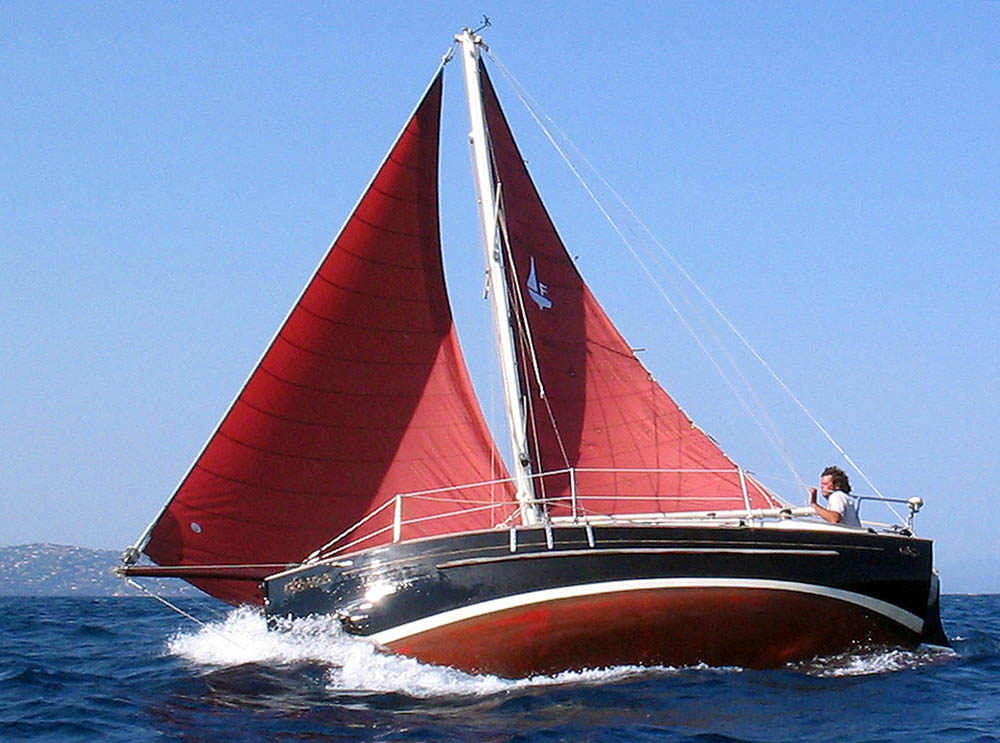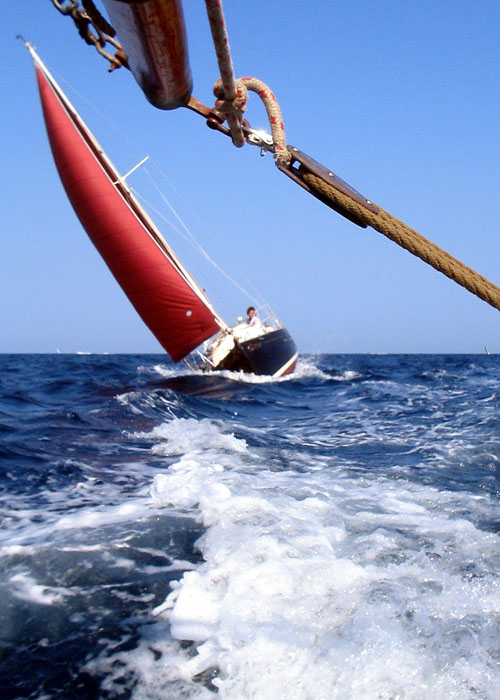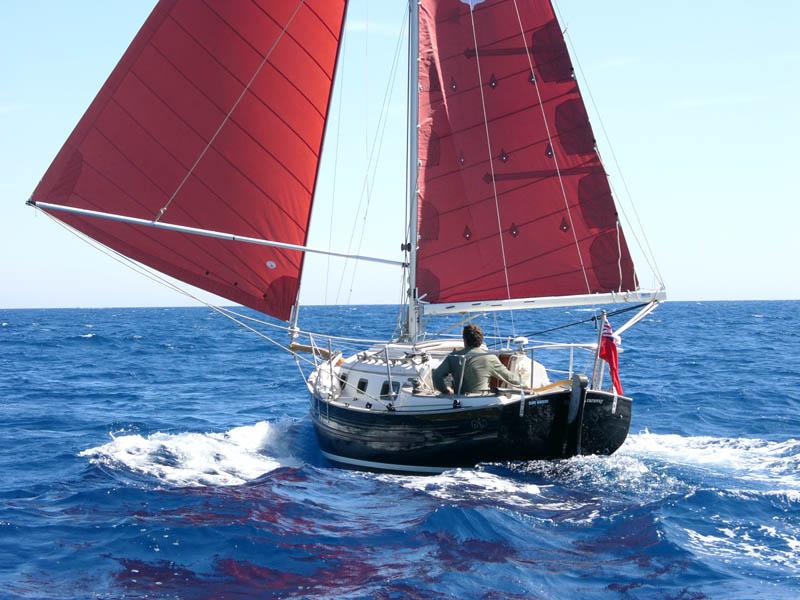Flicka Sailing Performance
Rod Bruckdorfer and Charlie Dewell

When people ask, "how well does she sail?", there are two common replies. "A Flicka can sail faster than 6 knots" and "They can not sail out of their own way". Both answers are correct depending on the wind speed and conditions.
A better answer is "A Flicka can easily sail at 4-5 knots and on a reach she sometimes exceeds six knots, but in light airs a drifter is a plus". The key to sailing a Flicka is to understand that her stability is derived from her ballast. She has a wineglass-shaped cross section and as the wind increases the Flicka wants to heel. As the boat heels weather helm is induced and the sail plans center of effort must be moved forward in relation to the center of lateral resistance to balance the boat. Once these concepts are mastered the Flicka is one beautiful sailing machine for her diminutive size.
Under sail the boat is initially tender due to her wineglass sections. Going to weather in light airs she heels to about ten degrees. As wind speed increases she will assume 15 degrees of heel and in dirty conditions the angle of heel is between 15 and 20 degress, depending on wind strength and the amount of canvas one is comfortable flying. The key to working a Flicka to weather in winds equal to or greater than 20 knots is to set enough canvas aloft so she heels to 20 degrees. As she heels the moment of the sail plans centre of effort is moved outside the boat. When this occurs the Flicka develops weather helm quickly. The solution is to tuck a reef in to balance the helm - two fingers on the tiller. The one exception to this rule is when a 135% genoa is flown. The genoa moves the centre of effort aft and induces weather helm as the boat heels.
The solution is to reduce the headsail area by changing headsails or reefing. In 15 to 20 knots of wind boat speed to weather is between 4 and 5 knots depending on sea state. In 30 knots of wind or higher she will work to weather at 3.5 to 4 knots. The tack to tack angle is between 110 and 120 degrees.

Tacking the boat can sometimes be a challenge. Because of her full keel and forefoot she comes across the wind similarly to any boat with a full keel. Compared to a fin keeled boat or boat with a cut-away forefoot she tacks slowly. In most conditions, when the seas are moderate the Flicka tacks easily and on command.
When the seas become "dirty" and a 3 to 4 foot chop is running tacking can sometimes be a challenge. Because of her short ends and blunt bow, the boat wants to pitch as the bow is turned into the wind. The pitching motion causes her to lose speed and tacking can become difficult.
The key in these conditions is to time the tack in relation to the chop and to not let the headsail flog, which contributes to slowing the boat. It may be necessary to let the headsail back as she comes across the eye of the wind. This will push the bow off the wind. Once the tack is complete, as with most full keel boats she will fall off the wind and come back on tack as boat speed increases. In very trying conditions it may be necessary to wear round the boat, i.e. to turn the bow of the boat away from the wind and gybe her round onto the opposite tack.
Reaching in a Flicka is sheer joy. From a close reach to a broad reach she is in her element. Under these conditions, she heels between 10 and 15 degrees, depending on wind strength and is a happy "little ship". In 15 knots of wind she will reach at 5 knots or better and in 20 knots of wind, the boat will approach 6 knots and sometimes exceed 6 knots as the boat comes more and more off the wind.
As with windward work, the Flicka will start to develop weather helm. Tucking a reef in the main balances the boat by moving the sails' center of effort forward. A second step which may be taken to reduce weather helm is to flatten the main. This is accomplished by attaching a vang/preventer from the boom to the boat's toe rail. In addition to helping decrease weatherhelm, sail chafe on the shrouds is also decreased. A well balanced Flicka under these conditions can be steered with two fingers on the tiller.
The Flicka has two sailing weaknesses. One is in wind speeds of 10 knots or less. Under these conditions, a drifter should be flown. With a drifter, boat speed may exceed 4 knots in 10 knots of wind. In 5 knots of wind, the Flicka will sail at 2 to 2½ knots with a well set drifter and the main vanged to the toerail with a preventer. This stops the boom moving in the seaway, which causes the main to lose lift. The second weakness is her short ends and blunt bow.
In a steep chop, the boat will sometimes hobbyhorse. This may result from pinching the boat too high into the wind or not carrying enough canvas to drive the boat hard. Footing to weather instead of beating and driving the boat hard will correct this deficiency under most conditions.
How well does a Flicka sail?

For her size and displacement she is an exceptionally fine sailing machine. She is not only fast for her size, she is seaworthy, has a kind motion and a reputation for keeping her crew safe. In a personal conversation with Bruce Bingham, her designer, I remarked, "I don't know what you did when you designed the boat, but you created an extremely fast, seaworthy boat." Mr. Bingham replied, "I did nothing -- I just transferred the lines of the two boats I discovered near Wickford, Rhode Island."
In retrospect, what Bruce Bingham did was to not only give us a fine sailing machine which has stood the test of time, but he preserved a hull form that is part of America's maritime history. When you sail a Flicka, you are sailing a boat whose lineage can be traced to 1840.